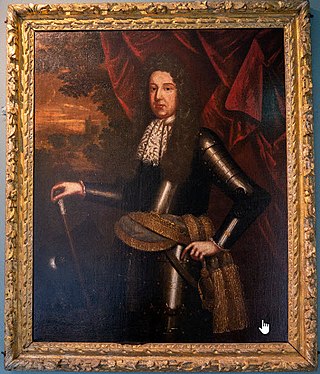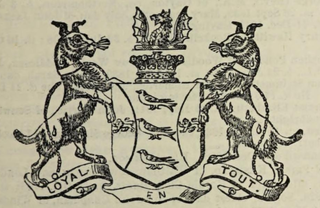
The title of Earl of Kenmare was created in the Peerage of Ireland in 1801. It became extinct upon the death of the 7th Earl in 1952.

Sir Donough MacCarty, 1st Earl of Clancarty (1594–1665), was an Irish soldier and politician. He succeeded his father as 2nd Viscount Muskerry in 1641. He rebelled against the government and joined the Irish Catholic Confederation, demanding religious freedom as a Catholic and defending the rights of the Gaelic nobility. Later, he supported the King against his Parliamentarian enemies during the Cromwellian conquest of Ireland.

Sir Valentine Browne, of Croft, Lincolnshire, was auditor, treasurer and victualler of Berwick-upon-Tweed. He acquired large estates in Ireland during the Plantation of Munster, in particular the seignory of Molahiffe. He lived at Ross Castle near Killarney, County Kerry. He was MP in three English and one Irish parliaments.

Thomas Dillon, 4th Viscount DillonPC (Ire) (1615–1673) held his title for 42 years that saw Strafford's administration, the Irish Rebellion of 1641, the Irish Confederate Wars and the Cromwellian Conquest of Ireland. He was a royalist and supported Strafford and Ormond. He sided with the Confederates for a while but was a moderate who opposed Rinuccini, the papal nuncio.
Sir James Dillon, 3rd Earl of Roscommon was an Irish magnate and politician. He was born a Catholic but converted at a young age to the Church of Ireland. He supported Strafford during his term as governor of Ireland. In the Confederate Wars and the Cromwellian conquest he was a royalist. He died in 1649, but was nevertheless included as the fifth on the list of people that were excluded from pardon in Cromwell's 1652 Act of Settlement.
Valentine Browne may refer to several members of the family of the Earl of Kenmare:

Connor O'Brien, 2nd Viscount Clare was the son of Daniel O'Brien, 1st Viscount Clare and Catherine FitzGerald, a daughter of Gerald, 14th Earl of Desmond.

Justin McCarthy, 1st Viscount Mountcashel, PC (Ire), was a Jacobite general in the Williamite War in Ireland and a personal friend of James II. He commanded Irish Army troops during the conflict, enjoying initial success when he seized Bandon in County Cork in 1689. However, he was defeated and captured at the Battle of Newtownbutler later in the same year. He escaped and was accused of having broken parole. After the end of the war, he led an Irish Brigade overseas for service in the French Army. He died in French exile.
Sir Valentine Browne, 1st Viscount Kenmare and 3rd Baronet Browne of Molahiffe (1638–1694), was an Irish Jacobite who fought for James II of England in the Williamite War in Ireland.
Sir William Parsons, 1st Baronet of Bellamont, PC (Ire), was known as a "land-hunter" expropriating land from owners whose titles were deemed defective. He also served as Surveyor General of Ireland and was an undertaker in several plantations. He governed Ireland as joint Lord Justice of Ireland from February 1640 to April 1643 during the Irish rebellion of 1641 and the beginning of the Irish Confederate War.

Callaghan MacCarty, 3rd Earl of Clancarty was the second son of Donough MacCarty, 1st Earl of Clancarty. Callaghan was destined for a Catholic religious career and entered a seminary in France where his family was in exile during Cromwell's rule. When his elder brother died in the Battle of Lowestoft, and the 2nd Earl, his nephew, died in infancy, he unexpectedly left his religious institution, returned to Ireland, and assumed the title. He became a Protestant and married a Protestant wife. Late in life he converted back to Catholicism.
Ulick Burke, 1st Viscount Galway was an Irish army officer slain at the Battle of Aughrim while fighting for the Jacobites during the Williamite War in Ireland.
Margaret Magennis, Viscountess Iveagh, also known as Margaret Butler, was the mother of John Butler, the de jure 15th Earl of Ormond. She is remembered by the song A Lament for Kilcash.

Sir Charles MacCarthy, 1st Viscount of Muskerry, also called Cormac Oge, especially in Irish, was from a family of Irish chieftains who were the Lords of Muskerry, related to the Old English through maternal lines. He became the 17th Lord of Muskerry upon his father's death in 1616. He acquired a noble title under English law, becoming 1st Viscount Muskerry and 1st Baron Blarney under letters patent. He sat in the House of Lords in both Irish parliaments of King Charles I. He opposed Strafford, the king's viceroy in Ireland, and in 1641 contributed to his demise by submitting grievances to the king in London. Muskerry died during this mission and was buried in Westminster Abbey.
David Roche, 7th Viscount Fermoy (1573–1635) was an Irish magnate, soldier, and politician.
Maurice Roche, 8th Viscount Fermoy (1597–1670) was an magnate and soldier in southern Ireland, and a politician of the Irish Catholic Confederation. He joined the rebels in the Irish Rebellion of 1641 in January 1642, early for Munster, by besieging Richard Boyle, 1st Earl of Cork, a Protestant, in Youghal. He fought for the Confederates in the Irish Confederate Wars and sat on three of their Supreme Councils. He fought against the Parliamentarians in the Cromwellian conquest of Ireland and was excluded from pardon at the surrender in 1652. At the restoration of the monarchy in 1660 he recovered his title but not his lands.

Cormac MacDermot MacCarthy, 16th Lord of Muskerry (1552–1616) was an Irish magnate and soldier. He fought at the Siege of Kinsale during Tyrone's Rebellion.
Sir Valentine Browne, 1st Baronet, of Molahiffe, owned a large estate in south-west Ireland and was a lawyer who served as high sheriff of County Kerry.
Redmond Roche was an Irish politician who sat for County Cork in the Parliament of 1640–1649. He was a Protestant during his earlier life but joined the Confederateses in 1642.

Nicholas Preston, 6th Viscount Gormanston (1606–1643) sat in the House of Lords of the Irish Parliament of 1634–1635 and sided with the insurgents after the Irish Rebellion of 1641.